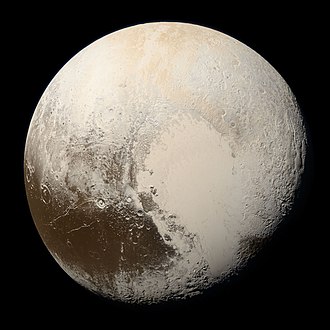Pluto: Difference between revisions
CSV import |
CSV import |
||
| Line 21: | Line 21: | ||
[[Category:Dwarf planets]] | [[Category:Dwarf planets]] | ||
{{astronomy-stub}} | {{astronomy-stub}} | ||
== Pluto == | |||
<gallery> | |||
File:Pluto monogram (bold).svg|Pluto monogram (bold) | |||
File:Pluto symbol (large orb, bold).svg|Pluto symbol (large orb, bold) | |||
File:Pluto in True Color - High-Res.jpg|Pluto in True Color - High-Res | |||
File:Pluto discovery plates.png|Pluto discovery plates | |||
File:Clyde W. Tombaugh.jpeg|Clyde W. Tombaugh | |||
File:Pluto monogram (fixed width).svg|Pluto monogram (fixed width) | |||
File:Pluto symbol (large orb, fixed width).svg|Pluto symbol (large orb, fixed width) | |||
File:Pluto symbol (southern Europe).svg|Pluto symbol (southern Europe) | |||
File:Pluto symbol (northern Europe).svg|Pluto symbol (northern Europe) | |||
File:Pluto symbol (northern Europe, variant).svg|Pluto symbol (northern Europe, variant) | |||
File:Charon symbol (fixed width).svg|Charon symbol (fixed width) | |||
File:Animation of Pluto orbit.gif|Animation of Pluto orbit | |||
</gallery> | |||
Latest revision as of 01:41, 20 February 2025





Pluto is a dwarf planet in the Kuiper belt, a ring of bodies beyond the orbit of Neptune. It was the first Kuiper belt object to be discovered and is the largest and second-most-massive known object in the belt. Pluto was discovered by Clyde Tombaugh in 1930 and was originally classified as the ninth planet from the Sun. However, after the discovery of similar-sized objects in the Kuiper belt, the International Astronomical Union (IAU) reclassified Pluto as a dwarf planet in 2006.
Discovery and Naming[edit]
Pluto was discovered on February 18, 1930, by Clyde Tombaugh at the Lowell Observatory in Flagstaff, Arizona. The discovery was the result of a search for a ninth planet, sometimes referred to as Planet X, which was hypothesized due to perceived irregularities in the orbits of Neptune and Uranus. The name Pluto, after the Roman god of the underworld, was proposed by Venetia Burney, an eleven-year-old schoolgirl in Oxford, England, and was officially adopted by the Lowell Observatory.
Physical Characteristics[edit]
Pluto is notable for its distinct orange-red color, attributed to the presence of methane ice on its surface. It has a highly eccentric and inclined orbit, which takes it from 30 to 49 astronomical units (AU) from the Sun. Pluto's orbit is also characterized by a 2:3 resonance with Neptune, meaning it completes two orbits around the Sun for every three orbits completed by Neptune.
Pluto's surface is composed of ice and rock, and it has a thin atmosphere that expands when it comes closer to the Sun and collapses as it moves away. Its largest moon, Charon, is so large relative to Pluto that they are sometimes considered a double dwarf planet system. Pluto has four other known moons: Nix, Hydra, Kerberos, and Styx.
Classification[edit]
The debate over Pluto's classification began in the late 20th century and culminated in 2006 when the IAU defined the term "planet" for the first time. According to this definition, a planet must orbit the Sun, be spherical in shape, and have "cleared the neighborhood" around its orbit. Since Pluto shares its orbit with other objects in the Kuiper belt, it does not meet the third criterion and was reclassified as a dwarf planet.
Exploration[edit]
Pluto remained a mysterious world until the arrival of the New Horizons spacecraft in 2015. Launched by NASA in 2006, New Horizons provided unprecedented images and data on Pluto, revealing a complex and varied surface with mountains, plains, and possibly even glaciers. The mission marked the first-ever close-up study of the dwarf planet and significantly expanded our understanding of it.
Cultural Impact[edit]
Despite its reclassification, Pluto remains a popular and beloved object in the solar system. Its demotion from planet status sparked widespread debate and interest in astronomy among the public. Pluto continues to captivate the imagination as a distant, icy world on the edge of our solar system.
Pluto[edit]
-
Pluto monogram (bold)
-
Pluto symbol (large orb, bold)
-
Pluto in True Color - High-Res
-
Pluto discovery plates
-
Clyde W. Tombaugh
-
Pluto monogram (fixed width)
-
Pluto symbol (large orb, fixed width)
-
Pluto symbol (southern Europe)
-
Pluto symbol (northern Europe)
-
Pluto symbol (northern Europe, variant)
-
Charon symbol (fixed width)
-
Animation of Pluto orbit











